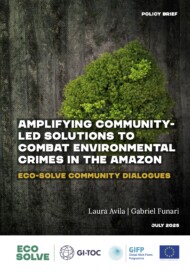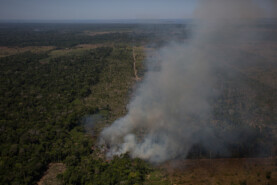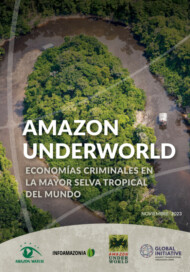Posted on 07 Nov 2025
When world leaders gather in Belém, Brazil, for the United Nations Climate Change Conference (COP30) next week, they will be confronting a crisis that goes far beyond deforestation: a criminal conflagration reshaping the world’s largest rainforest.
This is the first summit of its kind ever to be held in the Amazon region, and it could not be more timely. In recent years, the environmental threats facing the region have grown in profound and disturbing ways, and the situation is poorly understood from the outside. Illicit economies driving deforestation, such as mining, cattle ranching and logging, have escalated dramatically. Even the most remote and protected areas are now being invaded and exploited by organized criminal groups and violent cartels.
The crisis is largely due to the sharp rise in the gold price, which has led to a surge in illicit mining worldwide. In the Amazon, the impact has been profound. Gold’s dual role as a lucrative commodity and a tool for money laundering makes it a powerful amplifier of criminal economies. At the same time, the sustained increase in cocaine prices, coupled with volatile political and criminal dynamics – ranging from Colombia’s peace deal and Venezuela’s collapse to the explosive operational growth of Brazil’s largest criminal groups – has drawn new actors to the region. Armed groups and opportunists alike are diversifying their portfolios, while corrupt officials shield businesspeople operating in legal grey zones. The commodities and cash generated by these activities are then seamlessly laundered into global supply chains, where many prefer not to ask questions.
Many observers overlook the enormity of the issue because the Amazon and its Indigenous inhabitants have always experienced instability. New criminal activities coexist and overlap with traditional threats such as agribusiness, mega-projects and corruption. Much of this is underpinned by land grabbing, an organized and illegal practice with deep roots. However, today’s illicit economies are more formidable than before, with more money, more participants and a greater diversity of organizations fuelling extraction and destruction.
The consequences for the forest and its people are stark. In Peru alone, 140 000 hectares of trees have been cleared by illegal mining operations since the gold price took off in 2018. Mercury from illegal mining and the toxic chemicals used in cocaine processing have poisoned waterways and soil. Illicit networks are carving out roads, ports and airstrips that will open up the forest to further destruction, while old growth is being cleared to make way for illicit agribusinesses. Deforestation rates vary across the region, but the cumulative damage is immense, and the chemical contamination will endure for generations. The Amazon is the planet’s green lung, and there is no credible way to avoid catastrophic climate change without safeguarding its health.
The last comparable surge in environmental crime was the rhino and elephant poaching epidemic that peaked around 2016, driven by rising consumer demand in Asia. This twin crisis transformed the response to wildlife trafficking, as global concern for the charismatic species elevated the issue’s geopolitical profile. The result was an influx of funding, new legislation and the creation of specialized enforcement and multilateral instruments. However, there were also problematic outcomes, most notably the militarization of conservation efforts in some parts of Africa.
Nevertheless, it left a legacy. Many countries rewrote their penal codes and set up dedicated police units to pursue organized environmental criminals. The idea that wildlife trafficking was a serious offence with a transnational impact gained international traction, and tentative plans emerged to address corruption, financial flows and consumer demand, although most of these remain only partially realized.
While these changes eased the pressure on elephant populations and improved the ability to combat wildlife crime more broadly, the situation for rhinos remains mixed. Trafficking persists at high levels due to weak political will, poor enforcement, impunity for facilitators and ongoing demand. Yet this episode demonstrated that global norms can change, and similar adjustments are now emerging in responses to the Amazon crisis.
This new climate crisis has accelerated a move away from a narrow focus on wildlife trafficking towards broader categories such as ‘crimes that affect the environment’, the umbrella term promoted by the United Nations Office on Drugs and Crime. The development highlights the link between crimes that harm biodiversity and those that undermine global climate goals, a relationship that commands greater geopolitical attention. Furthermore, unlike the militarized response in Africa, international attention is helping to place Indigenous and forest-dependent communities in the Amazon at the forefront of the debate, where they are rightly insisting that land rights, protection for environmental defenders and sustainable alternative economies are essential to protecting their forest.
These are important narrative shifts that indicate that perhaps, over time, norms could adjust too. On the ground, practice is also evolving. For example, under President Luiz Inácio Lula da Silva, Brazil has created a police department dedicated to crimes in the Amazon and launched major operations to expel illegal miners and ranchers from Indigenous lands. The state and civil society are partnering more often to deploy innovative remote-sensing tools that detect illegal activities. New multi-agency fusion centres are improving cooperation across borders. Countries like Brazil and Peru are spearheading efforts to establish international frameworks to harmonize laws and reinforce responses to organized environmental crime. Colombia, meanwhile, is calling for stronger systems to trace gold supply chains – a proposal backed by agreements such as the recent Bogotá Declaration.
Linked to this regional activity is a wider push to institutionalize global burden-sharing. The tone is strikingly different to that of the poaching-crisis era, when Northern donors funded and steered reforms, an approach that provoked accusations of neocolonialism. Today, the charge is being led by the Global South, and the cost the region pays for the inaction of other countries is being emphasized. The Amazon crisis has also revived calls for a clean-up of global supply chains, with less faith being placed in the voluntary certification of a commodity’s origin and more in formal regulation and forensic testing.
Some might argue that framing environmental issues as crises can be counterproductive, as it can encourage short-term thinking and divert attention from other pressing environmental concerns. However, the crisis framing has a crucial advantage: It creates the kind of public urgency that compels public attention and political action. Charismatic species like elephants and iconic ecosystems like the Amazon rainforest benefit from this heightened concern, which is essential for building the sustained, long-term responses that environmental crimes ultimately require.
But the risks of missteps are high. The main danger is the securitization of environmental protection, and the reflexive temptation to treat every challenge in South America as part of the drug war. Front-line defenders are exposed to great danger and, despite the rhetoric, the situation remains dire. The poaching-crisis era revealed corruption, illicit financial flows and the issue of burden-sharing – critical problems that are just as challenging today.
Anyone observing closely would have no doubt that saving the Amazon – and, by extension, the planet – now hinges on tackling the illicit economies embedded within it. The ramifications are far-reaching: the success or failure of these policies will determine our ability to confront criminals in other forests and ecosystems. For better or worse, this is now the crisis that will define what it means to fight environmental crime.



